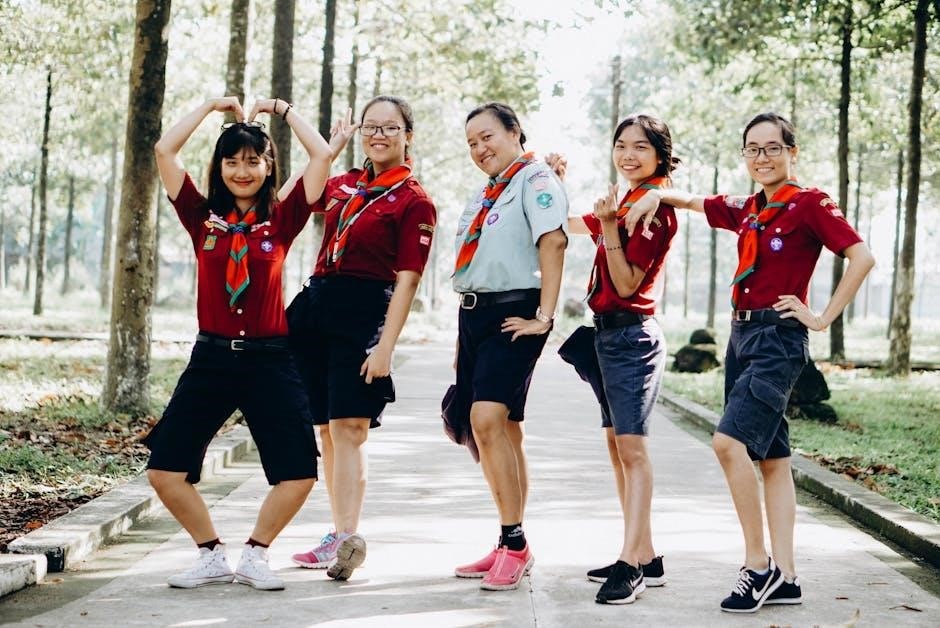The BSA Troop Guide is an essential resource for Scoutmasters and leaders, offering insights into managing troops effectively. It covers program basics, leadership strategies, and safety protocols, ensuring a well-organized and engaging experience for Scouts.
Overview of the Scouts BSA Program
The Scouts BSA program is designed to foster youth development through outdoor adventures, skill-building, and community service. It emphasizes leadership, character development, and citizenship, preparing young people for life’s challenges. The program is structured to engage Scouts in activities that promote teamwork, problem-solving, and personal growth. Leaders play a pivotal role in guiding Scouts through these experiences, ensuring a safe and inclusive environment. The Scouts BSA program is tailored for youth of various ages and skill levels, offering a progressive learning path that builds confidence and resilience. By participating in troop activities, Scouts develop essential life skills while forming lasting friendships and memories.
Purpose of the Troop Leader Guidebook
The Troop Leader Guidebook serves as a comprehensive resource for adult leaders in Scouts BSA, providing practical advice and strategies to effectively manage and lead a troop. It is designed to empower leaders with the knowledge and tools needed to create a dynamic, engaging, and safe Scouting experience for youth. The guidebook covers essential topics such as program planning, leadership techniques, and troop operations, ensuring leaders are well-equipped to foster growth and development in Scouts. By following its principles, leaders can create a positive and inclusive environment that aligns with the Scouts BSA mission and values. It is a vital tool for both new and experienced leaders.
Structure of the Guidebook
The BSA Troop Leader Guidebook is organized into clear, logical sections to help leaders navigate its wealth of information seamlessly. It begins with an introduction to the Scouts BSA program and the role of a troop leader, followed by detailed chapters on troop culture, activity planning, and operational management. Each section is divided into subtopics, such as recruitment strategies, safety protocols, and leadership techniques, ensuring leaders can quickly find relevant guidance. The guidebook also includes appendices with forms, checklists, and resources to support practical application. This structured approach makes it easy for leaders to access the information they need to manage their troop effectively and confidently.

Understanding the Role of a Troop Leader
A troop leader serves as a mentor, guide, and role model, fostering Scouts’ growth, ensuring safety, and promoting engagement in Scouting activities and values.
Responsibilities of a Scoutmaster
The Scoutmaster is central to the troop’s success, responsible for setting the vision, training adult leaders, and ensuring a safe, engaging program for Scouts.
They oversee troop meetings, outdoor adventures, and the implementation of the Scouts BSA program, fostering a culture of teamwork and leadership development.
The Scoutmaster also mentors youth leaders, helping them build skills and confidence, while maintaining communication with parents and ensuring compliance with BSA policies.
Duties of Assistant Scoutmasters
Assistant Scoutmasters play a vital role in supporting the Scoutmaster and ensuring the troop’s program runs smoothly. They assist with training, mentoring, and guiding Scouts, helping them develop leadership and life skills.
Responsibilities include leading troop meetings, organizing activities, and assisting with outdoor adventures. They also help with youth protection, ensuring safety protocols are followed and Scouts are well-supervised.
Assistant Scoutmasters often specialize in specific areas, such as teaching skills, managing equipment, or coordinating events, while maintaining open communication with the Scoutmaster and other leaders to achieve troop goals.
Engaging Parents and Volunteers
Engaging parents and volunteers is essential for a thriving troop. Scoutmasters should foster open communication, ensuring everyone feels valued and informed. Regular updates via emails, meetings, or newsletters help keep parents involved. Recognizing contributions, whether big or small, encourages continued support.
Leaders should identify volunteers’ skills and interests to match them with appropriate roles, such as event planning or skill instruction. Providing opportunities for parents to participate in activities strengthens the troop community. Encouraging parents to take on leadership roles or assist with specific tasks ensures a well-rounded program. A collaborative environment benefits both Scouts and adults, fostering growth and teamwork.

Building a Strong Troop Culture
A strong troop culture fosters a positive, inclusive, and respectful environment, encouraging collaboration, teamwork, and camaraderie among Scouts and leaders, aligned with the Scout Oath and Law.
Creating a Positive Troop Environment
Creating a positive troop environment involves fostering open communication, respect, and inclusivity among Scouts and leaders. Leaders should encourage teamwork, camaraderie, and a growth mindset, while promoting the Scout Oath and Law. By setting a tone of empathy and trust, Scouts feel valued and supported. Recognizing achievements and efforts, no matter how small, boosts morale and engagement. Leaders should also model positive behavior, demonstrating patience, fairness, and enthusiasm. A positive environment helps Scouts develop confidence, build strong relationships, and thrive in their Scouting journey. Consistent reinforcement of these values ensures a healthy, productive, and enjoyable troop culture for all members.
Encouraging Scout Participation
Encouraging Scout participation involves creating opportunities for Scouts to take ownership of their experiences. Leaders should empower Scouts to lead meetings, plan activities, and make decisions, fostering a sense of responsibility and engagement. Personalized approaches, such as matching tasks to individual interests, can motivate Scouts to contribute. Positive reinforcement, like recognizing achievements and celebrating progress, boosts confidence and encourages involvement. Providing a variety of engaging activities, including outdoor adventures and skill-building exercises, keeps Scouts interested and invested. Leaders should also ensure that every Scout feels included and valued, creating a sense of belonging that promotes active participation and enthusiasm for Scouting.
Setting Clear Expectations
Setting clear expectations is essential for a well-functioning Scout troop. By defining roles, responsibilities, and behavior guidelines upfront, leaders create a structured environment where Scouts understand what is expected of them; Clear communication of these expectations ensures consistency and fairness. Leaders should involve Scouts in discussions to set mutual goals and behavioral standards, fostering accountability and teamwork. Regular reminders and positive reinforcement help maintain adherence to these expectations. When expectations are clear, Scouts are more likely to stay engaged, demonstrate respect, and contribute positively to the troop’s success. This clarity also supports a safe and disciplined environment, promoting personal growth and leadership development.

Planning and Organizing Troop Activities
Effective planning ensures engaging, skill-building experiences for Scouts. Leaders must organize activities that align with program goals, promoting teamwork, safety, and fun while fostering youth leadership.

Effective Meeting Planning
Effective meeting planning is crucial for impactful troop activities. Start by setting clear objectives aligned with Scouting goals. Involve Scouts in planning to ensure relevance and engagement. Create a detailed agenda, allocating time for each segment. Include icebreakers, skill instruction, and team-building exercises. Ensure Scouts take leadership roles to develop their skills. Plan for interactive elements like games or discussions to maintain interest. Assign responsibilities to adult leaders and Scouts to promote accountability. End meetings with a recap and next steps to reinforce learning. Regularly evaluate meetings to refine formats and keep content fresh. This approach fosters a productive, enjoyable experience for all participants.
Organizing Outdoor Adventures
Organizing outdoor adventures requires careful planning to ensure safety and engagement. Begin by selecting a suitable location based on troop abilities and interests. Develop an itinerary with clear start and end times, including activities like hiking, camping, or team-building exercises. Ensure all necessary permits and approvals are obtained. Conduct a pre-trip meeting to review plans, safety protocols, and packing lists. Assign responsibilities to Scouts and adults, fostering leadership skills. Prepare for emergencies with a first aid kit, emergency contacts, and a contingency plan. Emphasize environmental stewardship, teaching Scouts to leave no trace. Ensure all participants are aware of safety guidelines and BSA policies. This approach ensures memorable and safe outdoor experiences.
Ensuring Safety in All Activities
Ensuring safety in all activities is a top priority for BSA troops. Leaders must develop and communicate clear safety policies, conduct risk assessments, and ensure all participants are trained in safety procedures. Proper supervision by qualified adults is essential, especially during high-risk activities. First aid kits and emergency communication devices should always be accessible. Leaders should review safety plans with Scouts and parents, emphasizing personal responsibility. Incident reporting and documentation are critical for accountability and continuous improvement. By adhering to BSA safety guidelines and fostering a culture of vigilance, troops can minimize risks and provide a secure environment for all members. Safety is everyone’s responsibility.

Recruitment and Retention Strategies
Effective recruitment and retention strategies are vital for building and maintaining a vibrant troop. Focus on engaging the community, offering meaningful experiences, and fostering strong relationships to attract and retain members.
Dynamic Recruitment Techniques
Dynamic recruitment techniques involve engaging potential members through active outreach and community involvement. Personal invitations, storytelling, and showcasing Scouts’ experiences can inspire interest. Hosting open houses, adventure showcases, or service projects attracts attention. Leveraging social media, school partnerships, and local events helps reach a broader audience. Emphasizing fun, adventure, and character development highlights the value of Scouts BSA. Creating a welcoming environment for new families ensures they feel included. Training existing members to be ambassadors also boosts recruitment efforts. These strategies foster growth and create a vibrant, inclusive troop culture.
Retention Strategies for Members
Effective retention strategies focus on fostering engagement, recognition, and a sense of belonging. Recognizing Scouts’ achievements through awards and praise motivates continued participation. Providing opportunities for leadership roles, such as patrol leader or quartermaster, empowers youth and strengthens commitment. Regular feedback and open communication ensure members feel heard and valued. Offering diverse and exciting activities aligns with their interests, keeping them enthusiastic. Building a supportive troop culture encourages camaraderie and shared goals. Involving parents in their child’s Scouting journey also enhances retention. Continuous improvement based on member feedback ensures the program remains relevant and fulfilling, promoting long-term involvement.
Engaging the Community
Engaging the community strengthens a troop’s connection and support base. Organizing public events, such as service projects or scouting fairs, fosters visibility and goodwill. Partnering with local businesses, schools, and organizations can provide resources and opportunities; Recognizing community contributions through awards or acknowledgments builds lasting relationships. Encouraging Scouts to share their experiences with local media highlights their achievements. Collaborating on issues like environmental conservation or food drives demonstrates Scouts’ commitment to societal improvement. By actively participating in community activities, the troop not only serves others but also attracts new members and garners support, ensuring a vibrant and sustainable Scouting program for years to come.

Training and Development
Training and development are essential for empowering leaders and Scouts with the skills, knowledge, and confidence needed to excel. Programs focus on leadership, safety, and continuous improvement, ensuring a well-rounded and impactful Scouting experience.
Adult Leader Training Programs
Youth Leadership Training
Continuous Learning Opportunities
Continuous learning opportunities are essential for both youth and adult leaders in the Scouts BSA program. The BSA offers a variety of resources, including online courses, workshops, and hands-on training, to ensure leaders are well-equipped to guide their troops effectively. These opportunities focus on developing skills in leadership, safety, and outdoor education. Leaders can participate in programs like the Philmont Training Center or local council events to enhance their knowledge. Additionally, regular updates on BSA policies and procedures are provided to keep leaders informed. Continuous learning fosters a culture of growth, ensuring that both youth and adults remain engaged and effective in their roles. This ongoing development is critical for maintaining a dynamic and informed troop leadership team.

Managing Troop Operations
Managing troop operations ensures smooth execution of activities, involving planning, resource allocation, and clear communication. It fosters a structured environment for youth and adult leaders to collaborate effectively.
Financial Management
Effective financial management is crucial for sustaining a troop’s operations. This involves creating a realistic budget, tracking expenses, and ensuring transparent use of funds. Troops often rely on dues, fundraising, and donations to cover costs like equipment, activities, and camp fees. Leaders should maintain accurate records and regularly report financial status to the troop committee. Proper fiscal practices build trust and accountability, ensuring resources are allocated wisely. Additionally, troops should follow BSA policies and guidelines to avoid monetary mismanagement. By fostering a culture of financial responsibility, leaders can secure the troop’s future and provide quality experiences for Scouts.
Equipment and Resource Management
Proper equipment and resource management is essential for a well-functioning troop. This includes maintaining an inventory of camping gear, tools, and supplies, ensuring they are in good condition and accessible. Regular inspections and maintenance help prevent damage and extend equipment lifespan. Leaders should designate a quartermaster to oversee gear organization and storage. Resources should be allocated based on troop needs and priorities. Training Scouts and adults on proper equipment use and care fosters responsibility. Budgeting for replacements and upgrades ensures the troop remains prepared for activities. Effective management of resources supports safe, engaging, and successful Scouting experiences for all members.
Effective Communication Channels
Establishing clear and effective communication channels is vital for a thriving troop. Regular updates through emails, group chats, or social media platforms ensure everyone stays informed. Face-to-face meetings, such as troop meetings or parent gatherings, foster direct interaction and clarity. Designated roles like the troop communicator or Scoutmaster can centralize messaging. Newsletters and websites are great for sharing updates, event details, and photos. Encouraging open dialogue during meetings and one-on-one conversations helps address concerns promptly. Setting clear expectations for communication, such as response times and feedback loops, ensures consistency. Training leaders in effective communication techniques further strengthens these channels, fostering a connected and informed troop community.

Advanced Leadership Techniques
Advanced leadership techniques focus on fostering growth, unity, and empowerment within the troop. Mentorship, adaptive leadership styles, and conflict resolution strategies enhance problem-solving and decision-making, creating a cohesive and resilient team.
Mentorship and Coaching
Mentorship and coaching are essential for developing young leaders and fostering personal growth within the troop. Scoutmasters should create opportunities for experienced Scouts to guide newer members, building confidence and skills. Consistent, positive feedback helps Scouts understand their strengths and areas for improvement. Leaders should encourage a culture of mutual respect and open communication, allowing Scouts to take ownership of their learning. By focusing on individual progress and providing tailored guidance, leaders empower Scouts to become capable, independent thinkers. Effective mentorship strengthens the troop’s overall performance and prepares Scouts for future challenges, both in and out of Scouting.
Conflict Resolution Strategies
Effective conflict resolution is crucial for maintaining harmony within the troop. Leaders should encourage open communication and teach Scouts to address disagreements calmly and respectfully. Active listening and remaining neutral help de-escalate tensions. Focusing on solutions rather than blame fosters collaboration. Scouts should learn to express their feelings clearly and respect differing perspectives. Leaders can model constructive conflict resolution by addressing issues promptly and fairly. Teaching Scouts to use tools like “Start, Stop, Continue” or “OTA (Oughta, Shoulda, Coulda)” can guide decision-making. By fostering a culture of respect and empathy, conflicts become opportunities for growth, strengthening relationships and the troop’s overall dynamic.
Adaptive Leadership Styles
Adaptive leadership styles are essential for Scoutmasters to effectively guide diverse groups. Leaders must assess individual and troop needs, adjusting their approach accordingly. Situational leadership, transformational leadership, and servant leadership models can be applied based on context. A leader may need to be more directive with younger Scouts and delegative with experienced ones. Flexibility fosters engagement and growth, ensuring Scouts are challenged appropriately. Understanding the troop’s dynamics and adapting leadership styles helps maintain unity and motivation. By being observant and responsive, leaders create an environment where Scouts thrive, preparing them for real-world challenges and fostering lifelong leadership skills through tailored guidance and support.

Specialized Topics
This section covers advanced areas such as safety protocols, supporting Scouts with special needs, and understanding BSA policies, ensuring leaders are well-prepared for unique challenges.
Guide to Safe Scouting
Safety is paramount in Scouting. The Guide to Safe Scouting provides essential guidelines to ensure all activities are conducted safely. It covers risk management, health standards, and emergency preparedness. Leaders must adhere to these policies to protect Scouts and volunteers. Key topics include incident reporting, first aid, and crisis management. The guide also emphasizes youth protection and proper supervision. By following these protocols, Scoutmasters can create a secure environment for Scouts to thrive. Regular updates ensure the guide aligns with current safety practices. Leaders are encouraged to review and implement these standards consistently to maintain a safe and positive Scouting experience for all.
Handling Special Needs Scouts
Scouting is inclusive, and troops must accommodate Scouts with special needs. Leaders should work with parents to understand individual requirements and develop tailored plans. This ensures all Scouts can participate safely and meaningfully. Training programs, such as the BSA’s Disability Awareness initiative, equip leaders with strategies to support Scouts with physical, emotional, or cognitive challenges. Adaptations might include modified activities or assistive devices. Open communication and patience are key to fostering an inclusive environment. By embracing diversity, troops empower Scouts with special needs to grow and thrive alongside their peers. Inclusion enriches the Scouting experience for everyone involved. Proper support ensures no Scout is left behind.
BSA Policies and Procedures
BSA policies and procedures are essential for maintaining a safe, structured, and compliant Scouting program. These guidelines ensure consistency across all troops and align with the organization’s mission and values. Key policies include youth protection, medical requirements, and financial oversight. Leaders must familiarize themselves with these rules to ensure compliance and accountability. Regular updates to policies reflect evolving standards and best practices. Troop leaders are responsible for enforcing these guidelines while adapting them to meet local needs. Adherence to BSA policies fosters trust, safety, and fairness within the troop. Proper implementation supports a positive and productive Scouting experience for all members. Understanding and following these procedures is critical for effective troop management and leadership. Stay informed to uphold the integrity of the program. Compliance ensures a secure and enjoyable environment for Scouts to grow and succeed.
Leading a Scouts BSA troop is a rewarding journey that shapes young lives. By following the guide, leaders can foster growth, teamwork, and character development effectively.
Final Thoughts on Troop Leadership
Troop leadership is a noble endeavor that requires patience, dedication, and a commitment to fostering growth in Scouts. Effective leaders inspire confidence, guide by example, and create an environment where youth can thrive. By balancing guidance with empowerment, leaders help Scouts develop essential life skills, resilience, and a strong moral compass. The role extends beyond meetings and campouts; it involves mentoring, encouraging, and nurturing the unique potential of each Scout. As leaders, we shape not only the troop’s culture but also the future of our communities. Embrace the responsibility with passion and purpose, knowing the lasting impact you will have on young lives.
Continuous Improvement in Troop Management
Continuous improvement is essential for maintaining a thriving troop. Regularly assess troop operations, seeking feedback from Scouts, parents, and leaders to identify areas for growth. Stay updated on BSA program updates and best practices to ensure relevance and effectiveness. Encourage a culture of learning, where both youth and adults can develop new skills and adapt to changing needs. By fostering innovation and reflection, leaders can address challenges proactively and enhance the overall troop experience; Continuous improvement ensures the troop remains dynamic, engaging, and aligned with its mission to prepare young people for life’s adventures. It’s a journey, not a destination, for everyone involved.
Resources for Further Development
Supplement your leadership skills with resources from the Boy Scouts of America. The BSA website offers training modules, webinars, and program guides tailored for troop leaders. Scoutmaster Specific Training and Wood Badge courses provide advanced leadership development. Additionally, the BSA Scout Shop offers manuals like the Scoutmaster Handbook and Guide to Safe Scouting. Online forums and local council workshops also connect leaders with shared experiences and best practices. Utilize these tools to enhance your troop’s effectiveness and stay updated on program advancements. Continuous learning ensures you’re equipped to deliver the best possible Scouting experience for youth.

